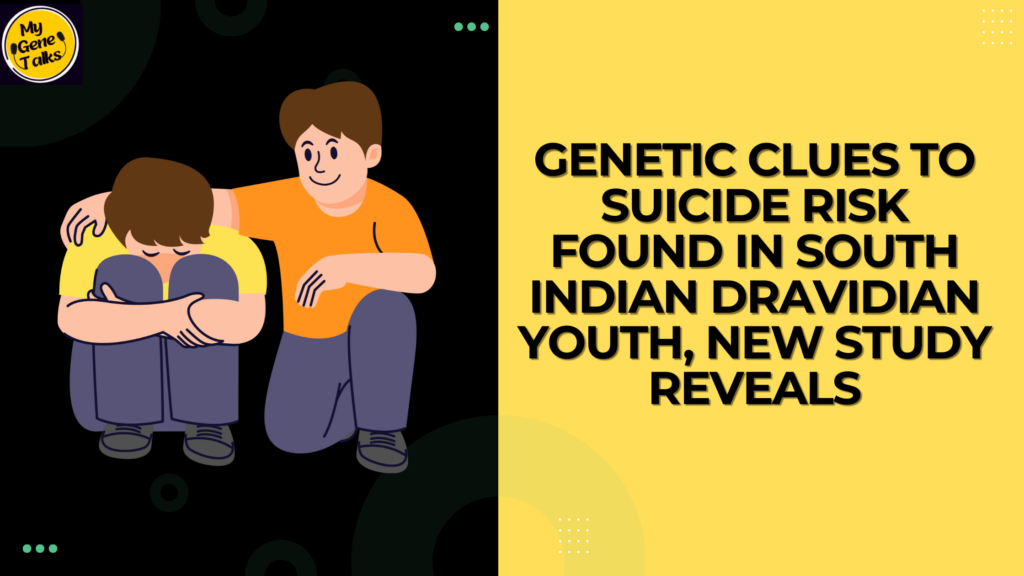Suicide remains one of the most destructive public mental health problem worldwide, specifical among adolescents and young adults. In India, we live in societal pressures, stigma around mental health, and limited access to psychiatric care, the issue becomes even more worsening. Alarming figures from the National Crime Records Bureau show that youth in the 18–30 age group accounted for more than one-third of total suicides in India during 2022. These statistics emphasise the urgent need to understand not just the psychological and social causes of suicide, but also the biological and genetic factors that may predispose individuals to such behavior.
A study recently published in the journal Biomarkers in Neuropsychiatry offers a groundbreaking milestone into the genetic cause of suicide attempts among South Indian adolescents and young adults. This specific study conducted by researchers from the Government Medical College and the Rajiv Gandhi Centre for Biotechnology in Kerala, this case-control study is among the first of its kind in the region. The researchers begin to investigate specific genetic variations single nucleotide polymorphisms (SNPs) in genes involved in serotonin and dopamine synthesis, transport, and degradation, both of which are neurotransmitter systems play critical role in mood regulation, impulsivity, and emotional resilience.
The study involved 80 cases of individuals aged 13 to 29 who had previously attempted suicide and 267 age, sex, and ethnicity-matched controls with no history of such behavior. All participants were from the Malayalam-speaking population in Kerala. By focusing on a genetically homogenous group, the researchers minimize confounding due to population stratification, a common issue in genetic studies. The primary objective of the study was to identify whether certain SNPs in genes related to the serotonin and dopamine systems could be associated with an increased risk of attempted suicide.
Among the genetic variants studied, two stood out with statistically significant associations. The first was the TH rs2070762 variant in the Tyrosine Hydroxylase gene, which plays a key role in dopamine synthesis. The T allele and TT genotype of this variant were significantly more common among suicide attempters than in the control group. The second significant variant was TPH1 rs211105 in the Tryptophan Hydroxylase gene, responsible for the initial step in serotonin biosynthesis. The G allele and the TG genotype of this variant were strongly associated with attempted suicide, with an odds ratio of 3.24. This is a particularly striking result, considering that serotonin plays a key role in mood stability, sleep, and stress responses. According to data from the Genotype-Tissue Expression (GTEx) project, the G allele of this SNP is associated with reduced expression of the TPH1 gene, potentially leading to lower serotonin production and increased vulnerability to mood disorders and impulsive behavior.
Interestingly, the other SNPs examined in the study including those in the COMT and 5HTR2A genes did not show statistically significant associations with suicide attempts. This divergence from previous studies conducted in Western populations suggests that genetic risk factors for psychiatric conditions may vary significantly across ethnic groups. It highlights the importance of conducting genetic studies in diverse populations, especially in regions like India, which are underrated in global genomics research. The strength of the study lies in its clear focus, rigorous methodology, and the ethnically matched design that enhances the reliability of its findings. The researchers confirmed robust genotyping through Sanger sequencing, PCR-based methods, and KASP allele discrimination techniques. Furthermore, all psychiatric evaluations were conducted by qualified trained professionals using standardized diagnostic guidelines, ensuring accuracy in identifying cases and controls.
However, the study is not without limitations. The relatively smaller sample size limits its statistical power. The researchers themselves acknowledge that a larger cohort is needed to confirm their findings and potentially uncover other relevant genetic variants. Moreover, the study focused solely on suicide attempts, without exploring related behaviors such as suicidal ideation or self-harm tendencies, which might also have genetic links. The key implications of the findings are significant. They support the growing understanding of suicidal behavior is not merely a response to life stress and social pressure but may also have a biological basis rooted in neurogenetic mechanisms. This opens the door to potential future applications in personalized medicine and mental health care. For example, identifying individuals with high-risk genetic profiles could enable early intervention and more tailored psychiatric support.
One of the most interesting aspects of the study is its contribution to the conversation around ethnic and population-specific risk factors. Many previous studies in Western populations have failed to replicate results across different ethnic groups, this study explains the importance of local genetic research for disclosing meaningful associations. The observation that the TPH1 rs211105 variant had a frequency pattern more aligned with African populations also points to shared ancestry or convergent genetic evolution that deserves further exploration. Ultimately, this study does not claim to have found “the gene” for suicide, nor does it imply that genetics alone can explain such a deeply complex behavior. Instead, it emphasizes that genetics may influence an individual’s baseline risk, potentially shaping how they respond to environmental stressors. Understanding this interplay may pave the way for more holistic and effective strategies in suicide prevention.
As suicide rates among Indian youth continue to increasing alarming rate, studies like this provide a much needed scientific foundation for public health interventions. The future of suicide prevention may lie on the intersection of genomics, psychiatry, and compassionate care.
Sources:
-
Mathew A, et al. (2025). Genetic predictors of attempted suicide among South Indian adolescents and young adults: A case-control study. Biomarkers in Neuropsychiatry. Original article: https://www.sciencedirect.com/science/article/pii/S2666144625000085
-
World Health Organization. Suicide Fact Sheet (2024)
-
GTEx Consortium Data



